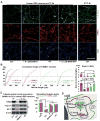iPSCs from a Hibernator Provide a Platform for Studying Cold Adaptation and Its Potential Medical Applications
- PMID: 29576452
- PMCID: PMC5935596
- DOI: 10.1016/j.cell.2018.03.010
iPSCs from a Hibernator Provide a Platform for Studying Cold Adaptation and Its Potential Medical Applications
Abstract
Hibernating mammals survive hypothermia (<10°C) without injury, a remarkable feat of cellular preservation that bears significance for potential medical applications. However, mechanisms imparting cold resistance, such as cytoskeleton stability, remain elusive. Using the first iPSC line from a hibernating mammal (13-lined ground squirrel), we uncovered cellular pathways critical for cold tolerance. Comparison between human and ground squirrel iPSC-derived neurons revealed differential mitochondrial and protein quality control responses to cold. In human iPSC-neurons, cold triggered mitochondrial stress, resulting in reactive oxygen species overproduction and lysosomal membrane permeabilization, contributing to microtubule destruction. Manipulations of these pathways endowed microtubule cold stability upon human iPSC-neurons and rat (a non-hibernator) retina, preserving its light responsiveness after prolonged cold exposure. Furthermore, these treatments significantly improved microtubule integrity in cold-stored kidneys, demonstrating the potential for prolonging shelf-life of organ transplants. Thus, ground squirrel iPSCs offer a unique platform for bringing cold-adaptive strategies from hibernators to humans in clinical applications. VIDEO ABSTRACT.
Keywords: cold adaptation; ground squirrel; hibernation; hypothermia; induced pluripotent stem cells; lysosomal membrane permeabilization; microtubule cold stability; mitochondria; organ storage; retina.
Published by Elsevier Inc.
Conflict of interest statement
The authors declare no competing financial interests. A provisional patent for the composition and methods to protect mammalian tissue against cold and other metabolic stresses has been filed by the NEI under US Application Serial No. 62/547,945.
Figures







References
-
- Andrews MT. Advances in molecular biology of hibernation in mammals. Bioessays. 2007;29:431–440. - PubMed
-
- Andrews ZB, Diano S, Horvath TL. Mitochondrial uncoupling proteins in the CNS: in support of function and survival. Nat Rev Neurosci. 2005;6:829–840. - PubMed
-
- Arendt T, Bullmann T. Neuronal plasticity in hibernation and the proposed role of the microtubule-associated protein tau as a “master switch” regulating synaptic gain in neuronal networks. American Journal of Physiology - Regulatory, Integrative and Comparative Physiology. 2013;305:R478–R489. - PubMed
Publication types
MeSH terms
Substances
Grants and funding
LinkOut - more resources
Full Text Sources
Other Literature Sources
Molecular Biology Databases
Research Materials

